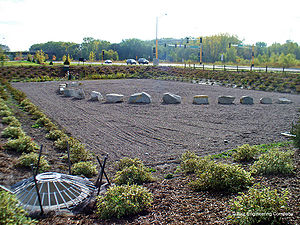
Difference between revisions of "Category:Level 3 - Best management practices/Structural practices/Sand filter, iron enhanced sand filter, media filter"
(Created page with "to be created") |
m |
||
| (4 intermediate revisions by the same user not shown) | |||
| Line 1: | Line 1: | ||
| − | to be | + | [[File:Beam Ave sand filter 1.jpg|thumb|300px|alt=photo of an iron ehanced sand filter basin|<font size=3>Iron enhanced sand filter basin, Maplewood, MN. Photo courtesy of Barr Engineering.</font size>]] |
| + | |||
| + | <font size=5>[[Sand filter|'''Main page for sand filter''']]</font size> | ||
| + | |||
| + | <font size=5>[[Iron enhanced sand filter (Minnesota Filter)|'''Main page for iron enhanced sand filter''']]</font size> | ||
| + | |||
| + | Sand filters, also called media filters or filtration basins, are a stormwater quality treatment system that works by capturing stormwater runoff and allowing this water to percolate through a sand-based filter media. Sand filters are very effective at removing sediment and pollutants attached to sediment. They do not provide reductions in the volume of runoff and have limited effectiveness for dissolved pollutants unless they are modified. They are suitable for all land uses, as long as the contributing drainage areas are limited (e.g., typically less than 5 acres). Media filters are not as aesthetically appealing, which makes them more appropriate for commercial or light industrial land uses or in locations that will not receive significant public exposure. Media filters are particularly well suited for sites with high percentages of impervious cover (e.g., greater than 50%). Media filters are typically designed with an underdrain, which makes them a good option for treating potential stormwater hotspots (PSHs). They can also be installed underground to prevent the consumption of valuable land space (often an important retrofit or redevelopment consideration). | ||
| + | |||
| + | This page (Category) contains links to pages and subcategories that provide information on sand filters, including iron enhanced sand filters. | ||
| + | |||
| + | [[Category:Level 2 - Best management practices/Structural practices]] | ||
Latest revision as of 00:12, 10 April 2023
Main page for iron enhanced sand filter
Sand filters, also called media filters or filtration basins, are a stormwater quality treatment system that works by capturing stormwater runoff and allowing this water to percolate through a sand-based filter media. Sand filters are very effective at removing sediment and pollutants attached to sediment. They do not provide reductions in the volume of runoff and have limited effectiveness for dissolved pollutants unless they are modified. They are suitable for all land uses, as long as the contributing drainage areas are limited (e.g., typically less than 5 acres). Media filters are not as aesthetically appealing, which makes them more appropriate for commercial or light industrial land uses or in locations that will not receive significant public exposure. Media filters are particularly well suited for sites with high percentages of impervious cover (e.g., greater than 50%). Media filters are typically designed with an underdrain, which makes them a good option for treating potential stormwater hotspots (PSHs). They can also be installed underground to prevent the consumption of valuable land space (often an important retrofit or redevelopment consideration).
This page (Category) contains links to pages and subcategories that provide information on sand filters, including iron enhanced sand filters.
Subcategories
This category has the following 2 subcategories, out of 2 total.
Pages in category "Level 3 - Best management practices/Structural practices/Sand filter, iron enhanced sand filter, media filter"
The following 16 pages are in this category, out of 16 total.
C
M
R
Media in category "Level 3 - Best management practices/Structural practices/Sand filter, iron enhanced sand filter, media filter"
The following 4 files are in this category, out of 4 total.
- Perimeter sand filter details.dwg ; 279 KB
- Surface sand filter details.dwg ; 298 KB
- Underground sand filter details.dwg ; 266 KB
This page was last edited on 10 April 2023, at 00:12.
